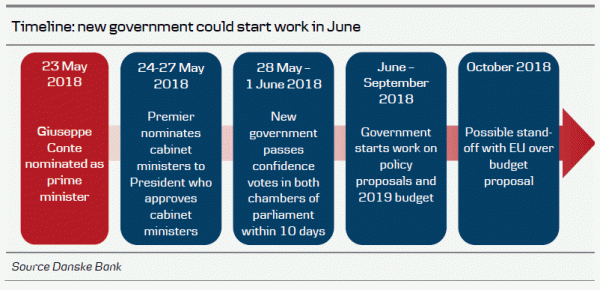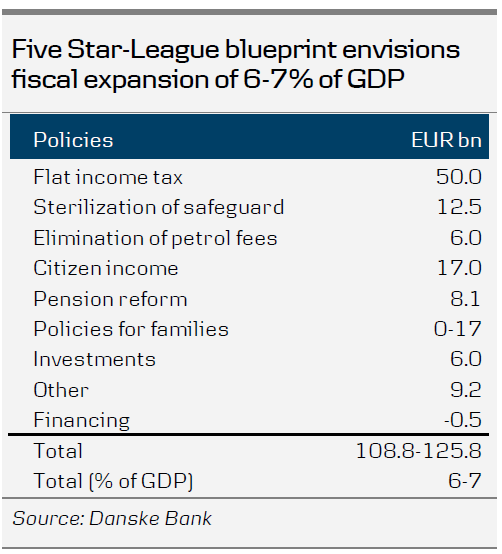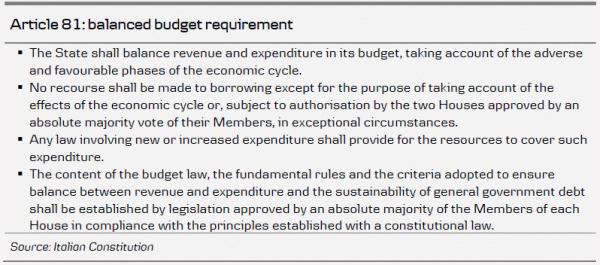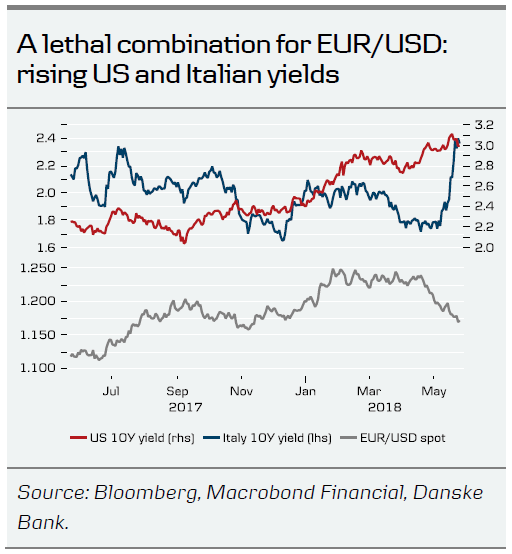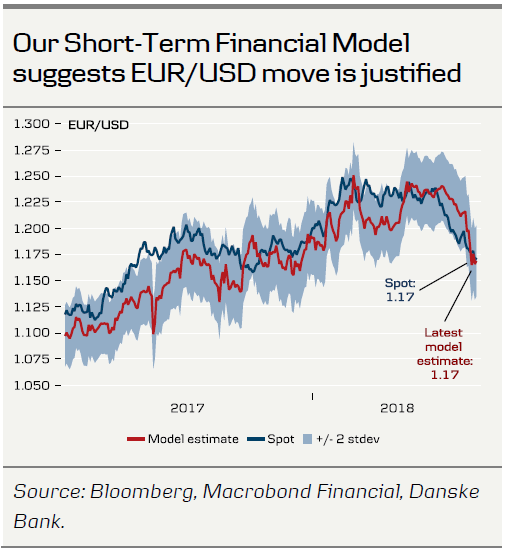- It will be difficult for the Five Star-League coalition government to fully implement its policy proposals, especially under rising market pressure and the moderating influence of the President.
- We expect a slow convergence between Italian government bonds relative to the core EU in the coming months, but still have a number risk factors ahead.
- Until more clarity regarding the actual policy implementation is obtained, an Italy risk premium will likely continue to weigh on the euro.
The personnel carousel keeps turning
Another hurdle was cleared in the Italian government formation process yesterday when President Mattarella affirmed law Professor Giuseppe Conte as Prime Minister and tasked him with forming a government. In his acceptance speech, Conte struck a relatively conciliatory tone, confirming Italy’s European and international ties, but he also pledged that the blueprint presented by Five Star and League last week will guide the government agenda. Conte will consult with party leaders today and over the next few days will propose the list of cabinet ministers to the president for approval. Only then can the new government move ahead in securing a vote of confidence in both houses of parliament (potentially sometime next week) and start moving ahead with some of its policy proposals as outlined in Italian Election monitor: Stand-off between EU and new Italian government looming. For now, the new cabinet looks likely to become a mix of technocrats and politicians. The choice of finance minister will be of particular market interest given that he sets the budget policy. An appointment of the euro-sceptic front runner Paolo Savona could trigger another deterioration in market sentiment and sound alarm bells in Brussels – but we would not rule out President Mattarella making use of his veto in this case, given his concerns about the economy and financial stability. According to Italian media, an alternative choice could be Luigi Zingales, a professor of finance at the University of Chicago, whose appointment would likely trigger a positive market reaction given his strong professional background. The two leaders of Five Star and League, Luigi Di Maio and Matteo Salvini, are expected to head the Economic Development and Interior ministries, respectively.
Policy implementation faces hurdles
Given that the government composition is yet unknown, it is difficult to say which policies would be prioritised, but we would expect that one of the first tasks of the government will be to work on the 2019 budget, which needs to be approved in the autumn. Although Italy has some fiscal leeway of around 0.7% of GDP (roughly EUR12bn), we think it will be difficult for the Five Star-League coalition government to fully implement its programme in its current from (pointing to a fiscal deficit of 6-7% of GDP). Firstly, bills regarding budgetary measures require approval by both chambers of parliament and the government would have to rely on a fairly slim majority of 6 seats in the Senate (31 seats in the lower house). This could prove a hurdle, for example when approving contentious measures, due to possible defections in the face of rising market pressure on Italian yields.
Furthermore, we expect President Mattarella to exert some moderating influence on exaggerated spending proposals. President Mattarella already indicated that he will play an active role in ensuring fiscal and political sustainability and accordance with international treaties of any bills presented to him for approval. The Italian President has the right to veto government bills which are deemed unconstitutional and may hence reject any legislation that threatens the stability of public finances and the balanced budget requirement according to Art. 81 (see box below). Although the two houses of parliament can override the president’s veto, Mattarella could still postpone the implementation of controversial measures. Especially costly proposals such as the universal basic income and the introduction of a flat tax rate with an estimated cost of EUR67bn alone look like plans that could meet with opposition from the President and might end up being watered down in our view. Other factors could also hamper the implementation process, such as the inherent mistrust between the two parties and a preference for delaying difficult measures, especially in the face of rising market pressure.
Standoff with EU looming – snap elections still possible
In our view the new Italian government will think carefully before picking its fights both domestically and abroad and not pursue a pure confrontational course with the EU from the beginning, despite its call for an overhaul of European fiscal and monetary rules. We could get a first glimpse of the future Italy-EU relationship at the European Council meeting at the end of June. Despite some member states such a France and rating agencies already voicing concerns of the new Italian government’s spending plans, we expect the EU to adopt a wait-and-see approach for now until more clarity is gained about the actual Italian 2019 budget proposal, to be submitted to Brussels by 15 October. We do not think the EU/European Commission will accept unfunded fiscal easing from Italy and in case of a clear violation of the Maastricht criteria, could for example launch an Excessive Deficit Procedure (EDP) against Italy
The new Italian government will be an inherently weak and fractious one and the risk of a government crisis and snap elections remains non-negligible in our view, especially in the face of rising market pressure on Italian debt servicing costs. We still see the risk of a pro-longed stand-off between the Italian government and the EU, but our base case remains that the Italian government will eventually conform with EU rules due to the reasons outlined above and agree to more moderate spending measures.
FI market: slow convergence to core EU with ‘bumps’ ahead
Italian bonds recovered slightly today, but the 10Y yield has reached 2.30%. The first comments from the new PM together with the possible choice of a finance minister that are “pro-business” such as Zingales will be supportive for the Italian government bonds. However, we still have a number risk factors in the coming months such as what fiscal policy will actually be implemented and how the fiscal expansion will be funded.
We expect that we will see a slow convergence between Italian government bonds relative to core-EU in the coming months, but there will be short-term “bumps” during the course of convergence. We have come too far to let the new Italian government derail the reform process that has been ongoing since the EU debt crisis began in 2011. We think the ECB will not be supporting Italy if the market sell offs on the back of a significant fiscal easing, that is deemed irresponsible. Here, we expect that EU and ECB will let the market pressure Italy towards a more responsible fiscal policy.
FX market: EUR debt risk revisited
Following complacency in the immediate aftermath of the election, EUR crosses have over the past week been markedly hit by the soaring Italian debt worries. As previously stressed, we think the Italy issue remains far from evolving into a new euro debt crisis, see e.g. Strategy – Italy under pressure – we keep our long position , but until more clarity regarding the actual policy implementation is obtained, an Italy risk premium will likely continue to weigh on the single currency. Notably, our Short-Term Financial Model for EUR/USD illustrates that the surge in Italian yields relative to Germany and the sustained uptick in US yields largely justifies the move towards 1.17. Lower levels in the cross could be tested but we have a hard time seeing November lows (watch out for 7-Nov low of 1.1554) being broken.




